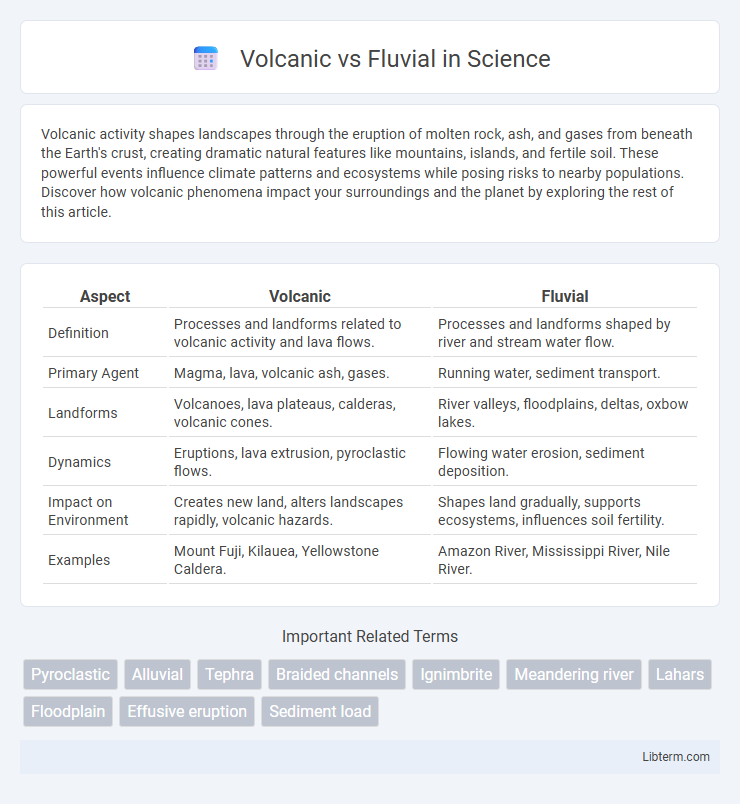Volcanic activity shapes landscapes through the eruption of molten rock, ash, and gases from beneath the Earth's crust, creating dramatic natural features like mountains, islands, and fertile soil. These powerful events influence climate patterns and ecosystems while posing risks to nearby populations. Discover how volcanic phenomena impact your surroundings and the planet by exploring the rest of this article.
Table of Comparison
| Aspect | Volcanic | Fluvial |
|---|---|---|
| Definition | Processes and landforms related to volcanic activity and lava flows. | Processes and landforms shaped by river and stream water flow. |
| Primary Agent | Magma, lava, volcanic ash, gases. | Running water, sediment transport. |
| Landforms | Volcanoes, lava plateaus, calderas, volcanic cones. | River valleys, floodplains, deltas, oxbow lakes. |
| Dynamics | Eruptions, lava extrusion, pyroclastic flows. | Flowing water erosion, sediment deposition. |
| Impact on Environment | Creates new land, alters landscapes rapidly, volcanic hazards. | Shapes land gradually, supports ecosystems, influences soil fertility. |
| Examples | Mount Fuji, Kilauea, Yellowstone Caldera. | Amazon River, Mississippi River, Nile River. |
Introduction to Volcanic and Fluvial Processes
Volcanic processes involve the eruption of magma from the Earth's mantle, resulting in lava flows, ash deposits, and pyroclastic materials that shape the landscape through volcanic cones and plateaus. Fluvial processes are driven by the movement of water in rivers and streams, causing erosion, transportation, and sediment deposition that form valleys, floodplains, and deltas. Understanding the dynamics of volcanic activity and fluvial erosion is essential for studying landform development and geological hazards.
Origins: How Volcanic and Fluvial Landforms Form
Volcanic landforms originate from the eruption of magma from beneath the Earth's crust, creating features such as volcanoes, lava plateaus, and volcanic cones as molten rock cools and solidifies. Fluvial landforms develop through the action of flowing water, where rivers and streams erode, transport, and deposit sediment to shape valleys, floodplains, and deltas. The fundamental difference lies in volcanic landforms being formed by igneous processes, while fluvial landforms result from sedimentary processes driven by water movement.
Key Differences in Geological Features
Volcanic landscapes are characterized by features such as lava flows, volcanic cones, calderas, and pyroclastic deposits formed from magma eruption and solidification. Fluvial geological features primarily include river channels, floodplains, alluvial fans, and sedimentary deposits shaped by the erosive and depositional actions of flowing water. The key difference lies in their formation processes: volcanic features result from igneous activity and magma extrusions, whereas fluvial features evolve through water erosion and sediment transportation.
Volcanic Landscapes: Characteristics and Examples
Volcanic landscapes are characterized by features such as lava flows, volcanic cones, craters, and ash deposits formed from eruptive activity. These terrains include prominent examples like the Hawaiian Islands, Mount Fuji in Japan, and the volcanic plateaus of Iceland, showcasing diverse formations from shield volcanoes to stratovolcanoes. The unique soil composition and geothermal activity in volcanic regions significantly influence local ecosystems and land use.
Fluvial Environments: Rivers, Erosion, and Sedimentation
Fluvial environments are shaped by the dynamic processes of rivers, where erosion and sedimentation continuously modify landscapes. River flow erodes bedrock and transports sediments downstream, depositing materials that form alluvial plains, deltas, and floodplains. These processes create diverse habitats and influence soil fertility, groundwater recharge, and sediment distribution in riverine ecosystems.
Influences on Ecosystems: Volcanic vs Fluvial Impacts
Volcanic influences on ecosystems primarily introduce nutrient-rich minerals and create new landforms that foster unique habitats, while fluvial impacts shape ecosystems through sediment transport, water flow regulation, and nutrient distribution along riverbanks. Volcanic eruptions can cause immediate ecosystem disruption but also promote long-term soil fertility, whereas fluvial processes support biodiversity by maintaining aquatic habitats and floodplain connectivity. Ecosystems impacted by volcanic activity tend to experience rapid successional changes, in contrast to the gradual but constant ecological modulation driven by fluvial dynamics.
Human Interaction with Volcanic and Fluvial Areas
Human interaction with volcanic areas often involves agriculture on fertile volcanic soils and geothermal energy exploitation, while also managing risks from eruptions. Fluvial areas support dense populations due to water resources, fertile floodplains, and transportation routes but require flood control infrastructure to mitigate seasonal flooding. Both environments demand sustainable land use planning to balance resource benefits and natural hazard prevention.
Hazards Associated with Volcanic and Fluvial Processes
Volcanic hazards include lava flows, pyroclastic flows, ashfall, volcanic gas emissions, and lahars, which can cause widespread destruction and health issues. Fluvial hazards primarily involve flooding, bank erosion, and sediment deposition, leading to property damage, loss of life, and ecosystem disruption. Both volcanic and fluvial processes significantly impact human infrastructure and natural environments through their dynamic and often unpredictable behavior.
Case Studies: Famous Volcanic and Fluvial Sites
The eruption of Mount Vesuvius in AD 79 offers a classic volcanic case study, showcasing pyroclastic flows that buried Pompeii under volcanic ash. In contrast, the Mississippi River Delta exemplifies a fluvial site shaped by sediment deposition, leading to fertile land and rich biodiversity. Both sites illustrate how volcanic activity creates dramatic, rapid landscape changes, while fluvial processes drive gradual terrain evolution through water movement.
Conclusion: Comparing Volcanic and Fluvial Landforms
Volcanic landforms, such as shield volcanoes and stratovolcanoes, are primarily shaped by magma eruption and cooling, resulting in distinctive elevated structures composed of igneous rock. Fluvial landforms, including river valleys, floodplains, and deltas, form through erosion and sediment deposition driven by flowing water, creating dynamic and often gently sloping landscapes. Comparing these, volcanic features are typically more abrupt and rugged due to rapid lava solidification, while fluvial landforms exhibit gradual morphologies shaped by continuous water action and sediment transport.
Volcanic Infographic

 libterm.com
libterm.com